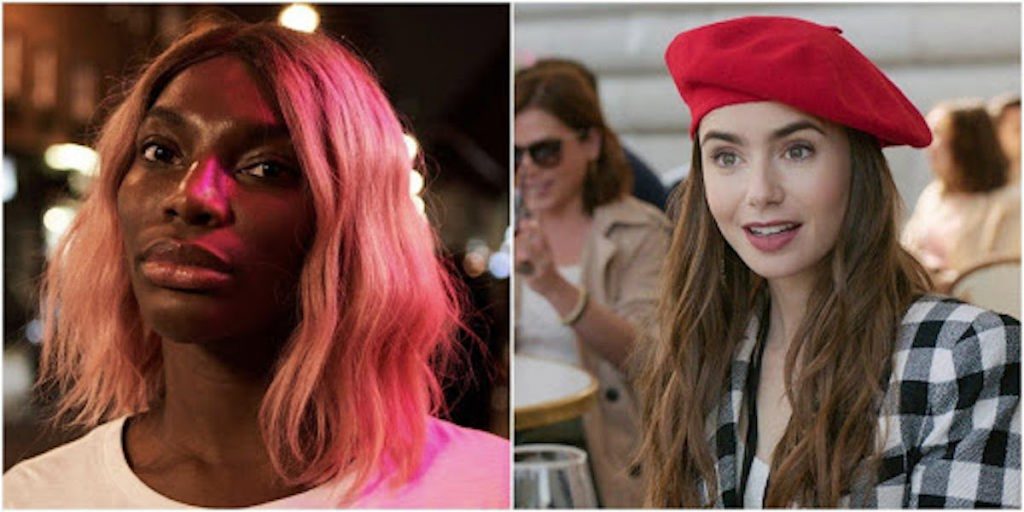Have you ever watched a piece of television or film that was so bad that you couldn’t help but keep watching? If you combine cringy acting with timeworn plotlines, questionable outfit choices and a touch of sheer inauthenticity, then voilà— you’ve conceived a trainwreck (spectacle de merde) you can’t look away from, and it goes by the name of “Emily in Paris.”
From “Sex and the City” creator Darren Star, “Emily in Paris” premiered last October with a 10-episode season that became a topic of disputed conversation among many social media outlets. However, the show recently received a Golden Globe nomination for Best Comedy or Musical series, and this has generated backlash from the public.
“Emily in Paris” and the White American Girl Gaze

The uncreative yet binge-worthy series was doomed from the start.
Its title “Emily in Paris” was originally written with a French accent so “Emily” and “Paris” could rhyme. However, its targeted audience (mostly white Americans) enunciated the title with their own inflections, removing the intentional rhyming and making the show sound similar to how the show feels: mind-numbingly bland.
“Emily in Paris” attempts to serve the white American girl gaze that regards foreign cities as personal playgrounds, as the main character Emily expects her visit to Paris to be a self-fulfilling adventure Yet, she is astonished when any aspect of the French culture deviates from the one she’s accustomed to in Chicago, Illinois.
However, the show only scratches the surface when representing French culture, perpetuating negative stereotypes of Parisians while romanticizing the city at the same time.
While the depiction of Paris seems disingenuous, the show’s centering on social media and marketing is painted inadequately, as Emily manages to charm a substantial amount of Instagram followers at an unbelievable pace and recites hollow marketing points that somehow impress clients.
In other words, everything is handed to her without her working for it. And although you want to be rooting for Emily’s success, you simply can’t bring yourself to it because her character is unbearable.
Why Emily’s Character Sucks

The show follows the journey of Emily Cooper, played by Golden Globe nominee Lily Collins, who gets to work for a luxury marketing company in Paris, France.
However, Emily doesn’t even bother to learn French.
She arrives in Paris only knowing words like “bonjour,” “enchanté” and “merde.” Even though she takes French classes that don’t really seem to help her, Emily goes out of her way to learn “I don’t speak French” in French, rather than attempting to master the language. Instead, she expects everyone to speak impeccable English because she’s a naive American girl.
While she doesn’t comprehend French, Emily has the nerve to either criticize or complain about the language, saying things like “your language is seriously effed up” and “French is such a funny language.”
And this is because she can’t fathom the cultural differences in Paris. She tells capital inhabitants that “the floor numbering here makes no sense” and they “reverse the dates” on their calendar.
In one particular scene, Emily receives a steak while dining out and sends it back to the chef because it’s “not correct” for her and that “the customer is always right.” When her friend, Mindy, counteracts this mindset by saying “here, the customer is never right,” Emily says she is determined to teach the chef “a little about customer service.” The audience is then forced to witness what it’s like when a Karen travels abroad.
Like many Karens, Emily doesn’t trouble herself to adapt to her surroundings but presumes they will eventually adapt to her, as she is the apex of white American girl privilege and gets everything handed to her without trying.
For example, Emily starts an Instagram account that rapidly increases in engagement throughout the series, yet her photos consist of awkward, close-up selfies and unsolicited pictures of children and women, who, at times, are made fun of by her.
Not only is Emily an impolite visitor, but she also makes a lousy friend, especially to her friend, Camille, who welcomes her to France and introduces her to many coveted clients. Emily returns the generosity by sleeping with Camille’s boyfriend and little brother.
But it’s Emily! And she’s in Paris! So it’s fine.
“Emily in Paris” Struggles with Introducing Diverse Characters

The show is overwhelmingly white with white leads and a few tokenized, one-dimensional characters that are from marginalized groups.
One supporting character is Emily’s best friend Mindy Chen, played by the Korean American actress Ashley Park. Park’s character is an heiress to her father’s zipper manufacturing company, which follows the depthless patterns of Asian representation by mimicking the standard image of “Crazy Rich Asians.”
Emily rarely asks about Mindy’s life, yet Mindy is continuously invested in Emily’s dilemmas and never fails in giving her guidance. This follows the shallow trope that the token best friend of color exists only in relation to the white protagonist and is always there to help them with their issues.
The same goes for Emily’s co-worker, Julien, (played by straight actor Samuel Arnold) who is an overbold gay Black man that comforts her whenever she in trouble with their boss. Julien’s character is designed to be the comic relief, with his saucy and surface level comebacks, and he has no other purpose beyond that.
The show never shows Julien outside of work or out of relation to Emily, which fuels the notion that gay men can only be a few things: sassy, campy and every straight woman’s sidekick.
Although they hire French actors, the show, in general, lacks accurate diversity with its characters, especially when neglecting other French communities, like the Morrocan immigrants who take up 20% of France’s immigrant population.
Moreover, “Emily in Paris” doesn’t seem to strive toward an authentic representation of France.
“Emily in Paris” Feels like Anti-France, Pro-America Propaganda
 The French are depicted as rude and ill-tempered juxtaposed with the seemingly sweet American protagonist, as florists deny Emily service without reason and coworkers constantly oppose her ideas. Mindy says it herself: “that’s the French way; they’re very disagreeable.”
The French are depicted as rude and ill-tempered juxtaposed with the seemingly sweet American protagonist, as florists deny Emily service without reason and coworkers constantly oppose her ideas. Mindy says it herself: “that’s the French way; they’re very disagreeable.”
The work ethic of the French is considered “lazy,” as their lunch breaks are extensive and they “work to live” rather than “living to work.”
Emily comes to France with the mantra, “I’m here to bring an American perspective on things, from a marketing point of view,” and, as this is repeated throughout the series, audiences are supposed to grasp the cultural differences between America and France and recognize that America is progressive while France supposedly stays rigid.
Two areas that the French seem to be behind in are the #MeToo movement and feminism.
Although the series heavily emphasizes the French’s approach to sexuality and sexual relationships, painting them as oversexed and resistant to monogamy, a lot of the French characters are illustrated as ignorant to issues such as sexism and the male gaze, and Emily, the American savior, is scripted to teach them about the objectification of women.
When confronting her boss Sylvie and her client, Antoine, Emily thinks that their perfume commercial won’t “translate in the states” because it’s “politically incorrect” for a woman to walk around naked with men staring. This insinuates that Americans have advanced from misogyny while the French remain ignorant to these types of conversations.
However, the show disregards the fact that France also had its own #MeToo movement called #BalanceTonPorc, translating to “out your pig”. Sylvie mentions the term but then claims that she is “a woman, not a feminist,” casting Emily as the socially aware American amongst “politically incorrect” acquaintances.
“Emily in Paris” and Golden Globe Nominations
Although “Emily in Paris” was a show that felt easy to watch, its shortcomings were hard to overlook — yet the Golden Globes seemed to have an easier time ignoring them. The show was nominated for not one but two awards. This raises questions about Hollywood and its “prestigious” award shows.
What stories do they perceive as greatness? Whose stories are they leaving out? Whose stories keep overshadowing ones that deserve recognition? “Emily in Paris” being nominated is a great example to use when approaching these questions.
Racism at the Golden Globes: “Emily in Paris” and “I May Destroy You”
Deborah Copaken, a writer for “Emily in Paris,” recently wrote in a Guardian article expressing her opinions on being nominated, while shows like “I May Destroy You” were snubbed from recognition.
Although Copaken was excited to see “Emily in Paris” being nominated for Best Comedy or Musical Series, she was also quick to address its weaknesses.
“Did I take the criticism of the show personally?” Copaken wrote. “Of course. Who wouldn’t? But also not. ‘Emily in Paris’ aired a few months after I’d spent June and July marching for racial justice through the streets of New York with my kids. I could definitely see how a show about a white American selling luxury whiteness, in a pre-pandemic Paris scrubbed free of its vibrant African and Muslim communities, might rankle.”
As stated by Copaken, the exclusion of “I May Destroy You” from the nominations list is indicative of greater race problems in Hollywood. A statistic from the nonprofit Color of Change that states that 91% of showrunners are white and 80% are men.
“Yes, we need art that reflects all of our colors, not just some,” Copaken writesshe wrote. “But we also need to give awards to shows (and music and films and plays and musicals) that deserve them, no matter the color of the skin of their creators. Is ‘Hamilton’ great because Lin-Manuel Miranda is Puerto Rican? No. It’s great because it bangs. By that same token, how anyone can watch ‘I May Destroy You’ and not call it a brilliant work of art or Michaela Coel a genius is beyond my capacity to understand how these decisions are made.”




